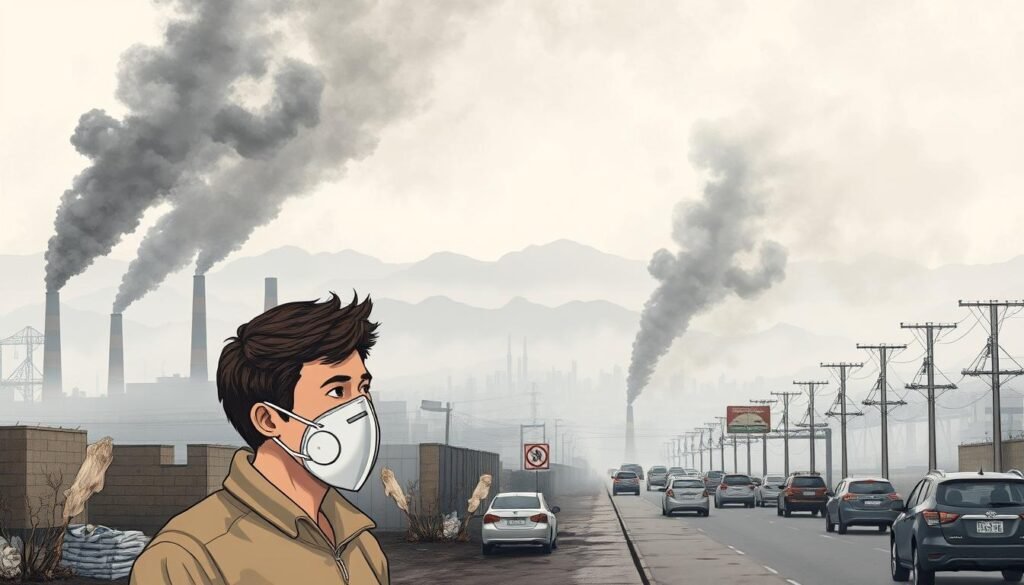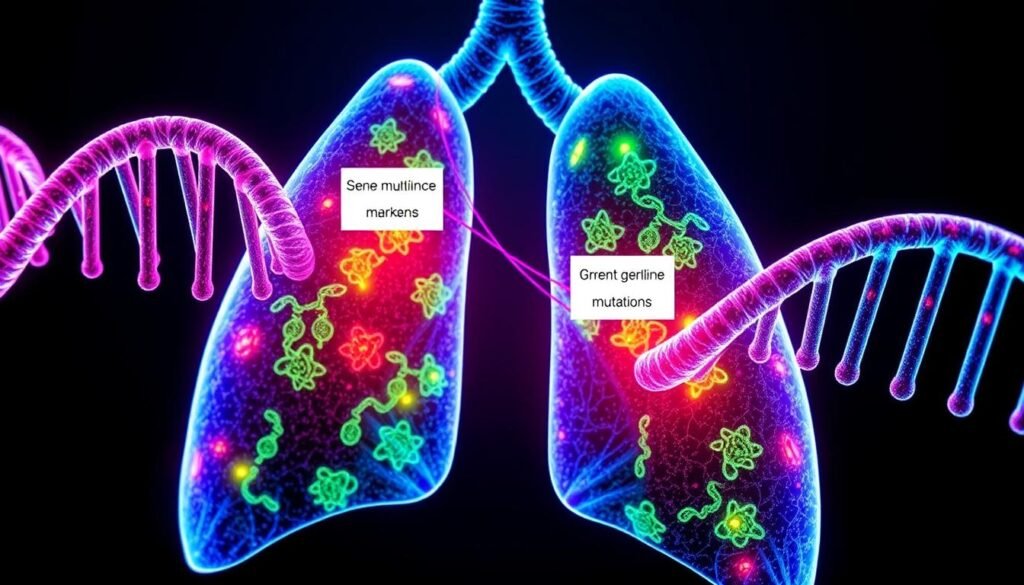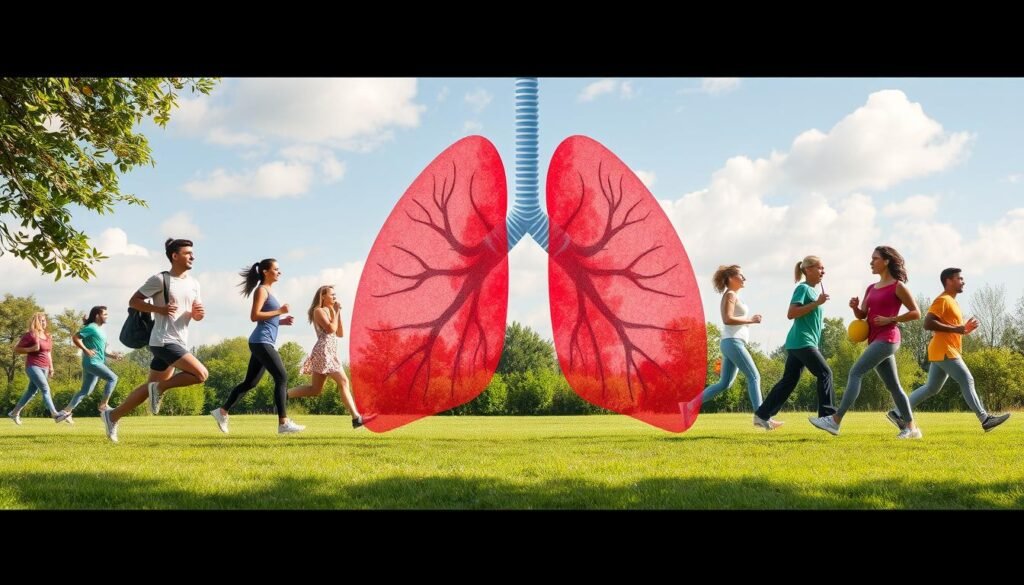Lung cancer causes around 1.37 million deaths worldwide every year. In the U.S. alone, there are over 234,000 new cases annually. Knowing the risk factors of this widespread disease is vital.
While smoking and environment play big roles, genetics cannot be ignored. People with family history of lung cancer are at greater risk. Knowing about genetic and environmental factors can help in prevention and early detection. We must better understand how chronic inflammation and the immune system play into this.
Interested in how allergies may impact lung cancer? For those curious, more about the link between allergies and lung cancer, including possible protective effects of chronic allergies, can be found here: allergies and lung cancer.
Key Takeaways
- Lung cancer leads to over 1.37 million deaths globally each year.
- Each year, over 234,000 Americans are diagnosed with lung cancer.
- Genes play a big part in lung cancer risk.
- Those with lung cancer in the family must be extra watchful.
- Smoking and environment majorly increase lung cancer risk.
- It’s crucial to understand both hereditary and environmental risks for prevention.
Introduction to Lung Cancer
Lung cancer is a major health issue in the United States. It greatly affects how common cancer is and the outcomes for patients. Most lung cancer comes from a type of cell called epithelial cells. There are two main kinds, small cell lung cancer (SCLC) and non-small cell lung cancer (NSCLC). NSCLC makes up about 80% of all lung cancer cases, being the most common form.
It’s very important to know about the types and risks of lung cancer. This is because it’s a top cause of death from cancer. Things in our environment, especially tobacco smoke, are big factors in starting and worsening this disease.
Now, genetics play a big role too in lung cancer. Though only 1% of cases are from genes we inherit, treatments aimed at certain gene changes are changing how we treat it. Tests for these genes are crucial. They help doctors pick the best treatments. Knowing about the different lung cancer types lets patients get care that’s just for them.
Scientists are looking into how gene changes, like those in the EGFR gene, impact treatment. This research is helping us understand the role of genetics in lung cancer better. Learning about lung cancer is opening up new ways for early detection and improving how well treatments work.
| Type of Lung Cancer | Percentage of Cases | Characteristics |
|---|---|---|
| Non-Small Cell Lung Cancer (NSCLC) | ~80% | Includes various subtypes; responsive to targeted therapies based on genetic testing. |
| Small Cell Lung Cancer (SCLC) | ~20% | More aggressive; currently lacks approved targeted therapies. |
What is Genetic Lung Cancer?
Genetic lung cancer covers various types influenced by genetics. These inherited changes greatly raise cancer risks. It shows cancer genetics matter as much as the air we breathe. It’s tricky to understand because both genes and lifestyle habits play a part.
Having a close relative with lung cancer ups your risk by 50%. This fact highlights the role of family history in genetic lung cancer risk. While smokers are at higher risk, 10-15% of cases are in non-smokers. This points to the role of factors beyond genetics.
Research has found genes linked to lung cancer, like EGFR, ALK, and TP53. While smoking is a big cause, genetic mutations can also lead to lung cancer. If you’re interested in learning more about genetics and lung cancer, check out this informative resource.
Understanding Genetic Risk Factors
Genes play a big role in lung cancer, especially in cases that run in families. Knowing how genetic risks work helps us find people who might get familial lung carcinoma. Family history plays a big part in figuring out the risk for lung cancer, even for those who don’t smoke.
Hereditary Lung Cancer: An Overview
Hereditary lung cancer comes from genes passed down in families. Changes in certain genes, like EGFR and KRAS, are common in lung cancer. These changes can cause cells to grow out of control, raising the risk of lung cancer.
About 8% of lung cancers are because of genes. People with these gene changes have a higher chance of getting lung cancer. This is especially true when they’re also around things in the environment that can cause cancer.
The Role of Family History in Lung Cancer
Having family members with lung cancer means your own risk could be higher. If one parent has a gene change, you might get it too. How genes and the environment work together makes lung cancer complex.
This connection to family means it’s important to talk about gene testing if you have a history of lung cancer. Such talks and tests can really help figure things out.
| Genetic Factors | Associated Risks |
|---|---|
| EGFR Gene Mutation | Present in up to 50% of lung cancer cases |
| KRAS Gene Mutation | Commonly involved in lung cancer pathogenesis |
| Other Notable Genes | MET, LKB1, BRAF, PIK3CA, ALK, RET, ROS1 |
| Genetic Testing | Guides treatment decisions and identifies risk |
Common Environmental Risk Factors
It’s important to know what causes lung cancer to avoid it. Smoking and radon exposure are the top causes. They greatly increase the risk of lung cancer, so understanding their effects is key.
Impact of Smoking on Lung Cancer Risk
Smoking is the number one cause of lung cancer. It leads to most lung cancer deaths in the U.S. Cigarettes have over 69 cancer-causing chemicals. The more and longer you smoke, the higher your lung cancer risk becomes. Smokers are 15 to 30 times more likely to get lung cancer than non-smokers. Even being around smoke can lead to lung cancer.
Radon Exposure: A Silent Threat
Radon is the second main cause of lung cancer. This gas is colorless and odorless, and it can build up in homes and buildings. It comes from the soil and is dangerous. Every year, radon causes about 21,000 lung cancer deaths. You can be at risk even if you’ve never smoked.

| Risk Factor | Impact on Lung Cancer | Statistics |
|---|---|---|
| Smoking | Leading cause of lung cancer; increases risk significantly | 80-90% of lung cancer deaths |
| Radon Exposure | Second-leading cause; affects non-smokers as well | 21,000 deaths annually |
| Secondhand Smoke | Increases lung cancer risk among non-smokers | Significant contributor to overall lung cancer cases |
Knowing about these risk factors helps communities and people act early. By being aware and avoiding these risks, we can greatly lower lung cancer chances.
Occupational and Chemical Exposures
Jobs have a big impact on lung cancer risk. This is because of various cancer-causing agents found at work. Construction and mining workers, for example, face risks from dangerous substances like asbestos. Knowing what these dangerous substances are helps make workplaces safer.
Carcinogens and Their Link to Lung Cancer
Many jobs expose people to carcinogens, which can cause cancer. The International Agency for Research on Cancer (IARC) groups these harmful agents based on their danger level. Chemicals that can really up the risk of lung cancer include:
- Asbestos
- Arsenic
- Beryllium
- Nickel
- Cadmium
- Chloromethyl ether
Studies show that up to 10% of lung cancers may come from job-related exposures. This fact underlines how crucial it is to protect against these dangers at work.
Asbestos and Lung Cancer Risk
Asbestos poses a big danger for people in construction and shipbuilding. Being around asbestos for a long time can seriously harm your health, including causing lung cancer. Breathing in asbestos fibers damages cells and raises the risk of both small cell lung cancer (SCLC) and non-small cell lung cancer (NSCLC).
Because asbestos is so dangerous, employers must follow strict safety rules. Making workplaces safer reduces the risks from job-related exposures and keeps workers healthy.
| Carcinogen | Common Industries | Health Risks |
|---|---|---|
| Asbestos | Construction, Shipbuilding | Lung Cancer, Mesothelioma |
| Arsenic | Mining, Electronics | Lung Cancer, Skin Cancers |
| Beryllium | Aerospace, Manufacturing | Lung Cancer, Chronic Beryllium Disease |
| Nickel | Metal Production, Mining | Lung Cancer, Allergic Reactions |
| Cadmium | Batteries, Recycling | Lung Cancer, Kidney Damage |
| Chloromethyl ether | Chemical Manufacturing | Lung Cancer, Respiratory Issues |
Age as a Risk Factor for Lung Cancer
Age is a big factor that affects the chance of getting lung cancer. Most people diagnosed are over 65 years old. The common age for this diagnosis is around 71, showing older age makes it more likely.
Research shows age and family history play a big part in lung cancer risk. If lung cancer hit a family member before 60, their kin have a much higher chance. This fact underscores the importance of age and family history.
Studies link aging to increased lung cancer risk. Aging by five years can raise that risk by 31%. Those who appear older biologically are at a 62% higher risk than the younger-looking ones. This info highlights how age changes lung cancer risk.
Smoking history mixed with age bumps up lung cancer risk greatly. An overwhelming 95.3% of studied cases were from people who have smoked. This shows a tight link between smoking, age, and lung cancer.
| Age Group | Odds Ratio (OR) | 95% Confidence Interval (CI) |
|---|---|---|
| Both diagnosed before age 60 | 4.89 | 1.47–16.25 |
| Relative diagnosed before age 60 | 2.08 | 1.20–3.59 |
| Biologically older group | 62% increased risk | N/A |
Knowing how age increases lung cancer risk highlights why early screening is critical for older people. Catching cancer early can lead to better treatment success and preventative measures.
Non-Genetic Factors Influencing Risk
Lung cancer is not just about genetics. It’s also about how we live and what’s around us. Things like lifestyle choices and environmental factors play a big part in risk. Making better choices and avoiding pollutants can help lower your chances of getting lung cancer.
The Effect of Lifestyle Choices
Lifestyle has a big impact on lung cancer risk. Smoking is a huge risk factor, causing about 80% of lung cancer deaths. Smokers are at a much higher risk than non-smokers. Bad eating habits, not exercising, and using things like marijuana also add to the risk. It’s important to manage stress and keep a healthy weight to reduce your chances of lung cancer.
The Impact of Air Pollution
Air pollution plays a significant role in lung cancer risk too. Experts have found that pollution, like diesel fumes in cities, adds to the problem. This kind of air pollution is linked to 1% to 2% of lung cancer deaths in the U.S. Also, radon gas is behind about 30% of lung cancer deaths among those who never smoked. As air quality gets worse in many places, it’s vital to understand its effects on our lungs.
| Factor | Influence on Lung Cancer Risk |
|---|---|
| Tobacco Use | Accounts for approximately 80% of lung cancer deaths |
| Air Pollution | Estimated to cause 1% to 2% of lung cancer deaths |
| Radon Exposure | Responsible for about 30% of lung cancer deaths in non-smokers |
| Asbestos Exposure | Increased risk, particularly for smokers; leads to a high percentage of lung cancer deaths |
| Diet and Exercise | Poor choices can increase overall lung cancer risk |
Genetic Lung Cancer: Understanding Your Risk Factors
Genetic factors matter a lot when it comes to lung cancer. We’ll look into genetic causes, like mutations and the chance of inheriting lung cancer. Knowing about these can help people take steps to stay healthy.
Germline Lung Cancer Mutations Explained
Germline mutations are DNA changes passed down through families. They make people more likely to get lung cancer. About 5% to 10% of all cancers come from such mutations. In lung adenocarcinomas, around 60% have these gene changes. That’s why it’s key to know about them. Finding these mutations helps doctors create the best care plans.
Inherited Lung Tumor Predisposition
Inherited lung tumor risk means you’re more likely to get lung cancer if it runs in your family. If lung cancer is common in your family, your own risk goes up two to three times. Even though hereditary lung cancer is rare, we can’t ignore genetic risks. That’s where genetic counseling and testing come in. They are vital for families worried about their risk of lung cancer.

Emerging Research in Lung Cancer Genetics
Research in cancer genomics is changing how we understand and treat lung cancer. Studies reveal complex genetic mutations that cause lung cancer. This opens the door for new therapies and better results for patients. These discoveries are key in reducing risks and improving prevention.
Cancer Genomics: What You Need to Know
Cancer genomics looks at DNA changes that lead to lung cancer. With new technologies, experts can spot specific mutations causing the disease. This means doctors can create more personalized treatments, improving how patients respond. The National Lung Screening Trial showed how critical early detection is, especially through low-dose CT scans, for high-risk groups.
Oncogenic Lung Pathways and Their Implications
It’s vital to understand oncogenic pathways to make targeted therapies. New approved drugs, like osimertinib (Tagrisso), attack certain EGFR gene mutations. Such targeted treatments help patients live longer. Also, drug combos, like dabrafenib and trametinib, work well for BRAF mutation patients. This highlights the importance of genetic profiling in treating lung cancer.
| Drug | Indication | Outcome |
|---|---|---|
| Osimertinib (Tagrisso) | EGFR mutations | Effective in early-stage NSCLC post-surgery |
| Sotorasib (Lumakras) | KRAS mutations | 82% tumor shrinkage observed |
| Atezolizumab (Tecentriq) | Adjuvant after surgery | Improved outcomes for early-stage patients |
| Repotrectinib (Augtyro) | ROS1 fusions | Approved for advanced or metastatic NSCLC |
Strategies for Lung Cancer Prevention
To prevent lung cancer, it’s key to limit contact with known risks. Most lung cancer deaths, about 87%, are due to smoking. This shows how vital programs that help people stop smoking are. They not only aid smokers but also benefit community health. By quitting, one’s chance of getting lung cancer drops greatly. In five years, the risk halves, and in ten, it’s almost like that of someone who never smoked.
Educational efforts about radon and its dangers are crucial. Radon is a common gas in homes and can increase lung cancer risk. By testing for and dealing with radon, we can protect against it. Also, we should avoid air pollution, at work and elsewhere. This helps lower risk as well.
Being active is another key strategy against lung cancer. Doing exercises like running or biking for 30 minutes, five times a week, is great for the lungs. Eating healthy is also important. A diet full of fruits, veggies, and grains, while avoiding bad fats and processed meats, is protective.
| Prevention Strategy | Description |
|---|---|
| Smoking Cessation | Programs designed to help individuals quit smoking, significantly reducing lung cancer risk. |
| Radon Awareness | Campaigns to educate about radon testing and treatment in homes to mitigate lung cancer risk. |
| Exercise | Regular aerobics for lung health; recommended for at least 30 minutes, five days a week. |
| Healthy Diet | Diet rich in antioxidants and low in harmful fats; promotes overall health and mitigates cancer risk. |
| Pollution Reduction | Efforts to decrease personal and occupational exposure to air pollutants and toxic substances. |
Teaching the community about how lifestyle affects lung health is vital. It links public efforts with personal action. For more tips on avoiding lung cancer, check out this helpful guide.

Living with a Family History of Lung Cancer
If your family has a history of lung cancer, knowing your risk is key. About 8-15% of lung cancer patients have hereditary mutations. This suggests genetics play a role in some cases. It’s particularly important for young people, women, and non-smokers to understand their genetic risks. Knowing about lung cancer awareness and taking action for your health is vital.
Genetic counseling is really important in dealing with these risks. It looks at your and your family’s health history to give personalized advice and screening recommendations. For example, if you’re 50-80 years old and have smoked a lot, you might need yearly CT scans. Talking openly with your doctors helps you know about your own risks.
Having family members with lung cancer can mean more than just genetics. It might also show shared environmental risks. Growing awareness helps us realize how important research is. It helps us understand how genetics and environment work together. Taking part in studies, like the one on Young Lung Cancer, helps improve prevention for those at risk.
Conclusion
Lung cancer is complex and requires understanding for effective risk management. It involves both genetics, like mutations on chromosome 15, and environmental factors. Studies show people with this mutation have a higher lung cancer risk by 30% to 80% if they smoke. Knowing about personal and family health history is key.
Research with over 35,000 people in Europe, the US, and Canada found specific genetic markers linked to lung cancer risk. These markers mean even non-smokers can be at higher risk because of their genes. On top of that, things in the environment like air pollution and asbestos increase the danger.
Healthcare workers must raise awareness and push for early detection and prevention. This approach not only helps people make better choices but also leads to better public health results. If people know the risks early, they have a better chance of surviving lung cancer.